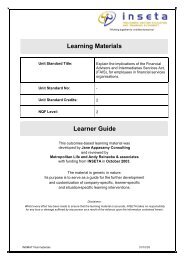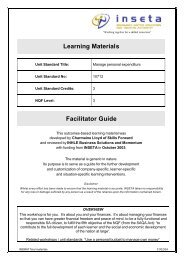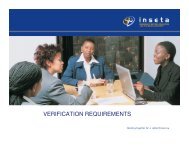SSP Brochure:Layout 1 - INSETA
SSP Brochure:Layout 1 - INSETA
SSP Brochure:Layout 1 - INSETA
Create successful ePaper yourself
Turn your PDF publications into a flip-book with our unique Google optimized e-Paper software.
The survey and the <strong>SSP</strong> development process also uncovered areas in which the <strong>INSETA</strong> itself could improve its service delivery in orderto facilitate the implementation of learnerships. These issues will receive attention in the future planning of SETA activities.3.4 Development of the existing labour force3.4.1 Continuing professional education (CPE)Continuing professional education is central to the further development of managerial, professional and technical staff in the industry. Manyof the professional bodies offer CPE themselves, accredit training providers to offer such training and assign CPE points to specific traininginterventions. In many instances, members retain memberships (and the use of professional designations) only if they accumulate sufficientCPE points over a specified period of time.3.4.2 In-service trainingEmployers in the sector play a key role in upgrading the skills of the current workforce. Most large employers provide extensive in-housetraining for employees, and some have established in-house corporate universities, centres of training excellence or training institutes. Someof these interventions are cascaded to intermediaries, but the majority are tailored to the needs of the organisations’ own employees.Independent intermediaries and brokers in the sector tend to rely on training services provided by large companies, especially in terms ofproduct knowledge. However, because of the FAIS legislation, intermediaries/brokers also seek external providers to assist them in meetingFAIS minimum requirements.The skills development priorities that employers set, and the number of people that they train at each NQF level, provide some insightinto the areas considered important and the efforts that go into the upgrading of employee skills. Companies that submitted WSPs for2006/2007 planned to train their employees in a wide array of skills areas. Most of the skills training would take place at NQF levels 4 and5 and in the areas technical and financial skills (Table 3-12).Table 3.12 Number of people to be trained according to skills development priorities of employers in the sectorSkills PriorityNQF Level1 2 3 4 5 6 7 8ABETAdministrative skills 17 96 249 496 103 8 1 0Client Services 0 0 0 30 0 0 0 0Coaching 0 0 0 0 0 1 0 0Communication skills 11 86 245 3 383 574 98 11 3Company Specific Procedures 0 0 0 4 0 0 0 0Computer skills 76 443 841 1 219 263 59 9 0Customer Care skills 104 57 295 1 922 273 22 5 0Diversity/Transformational skills 3 7 248 1 315 122 27 11 1FAIS Credit Bearing Training 0 0 0 62 5 0 0 0Financial skills 8 9 49 9 395 3 221 220 28 4Human Resource Development 42 8 32 340 82 48 41 4Leadership Development 0 0 0 0 0 0 2 0Legislative Compliance skills 13 41 264 4 754 2 806 165 22 1Life skills/Personal Mastery skills 73 28 764 1 282 699 86 35 3Management & Leadership skills 82 17 170 2 596 2 127 655 147 21Product Knowledge 0 0 50 100 0 0 0 0Professional Qualifications 0 0 0 0 8 0 29 3Sales/Marketing Skills 0 5 3 20 9 0 0 0Systems training 0 0 300 0 0 0 0 0Technical skills 283 48 1 398 20 268 7 530 334 77 36Source: WSPs submitted for year 2006/2007Table 3-13 shows the number and percentage of people in each occupational group who would receive training in 2006/2007. Employersplanned to train as many as 67% of their employees. More than 80% of the middle and junior managers would receive training.<strong>INSETA</strong> Sector Skills Plan - page 30
















